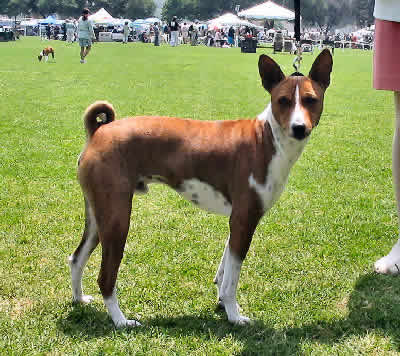
The Basenji is an energetic and playful dog. Its most unique characteristic is its bark, or lack thereof.
The Basenji makes a great pet as long as it is handled frequently starting when it is a puppy. Basenjis are mostly silent, and the noises they do make consist of yodeling and howling sounds. When selecting a Basenji, it is wise to check its bloodlines for Fanconi syndrome, Hemolytic Anemia and eye disorders. Other ailments to look out for include hip dysplasia and malabsorption.
- Kingdom: Animalia
- Phylum: Chordata
- Class: Mammalia
- Order: Carnivora
- Family: Canidae
- Genus: Canis
- Species: lupus familiaris
Common Name(s)
Basenji, African Bush Dog, African Barkless Dog, Ango Angari, Avuvi, Congo Dog, Zande Dog
Breed Type
The Basenji is a hound breed. They originated as hunting dogs, and are still used for hunting in Africa.
Background
The Basenji originated in Africa, where it was a favorite of Egyptian pharaohs. The breed wasn’t successfully brought to England until the 1930s, and was subsequently introduced to the United States. Most Western Basenjis are descended from the original imports, but more were imported from Africa in the 1980s to increase the gene pool.
Description
The Basenji has a smooth coat, and may be red, black, black and tan, or brindle, all of which are accompanied by white. Most have white on their feet, chest, and tip of tail, and some have white on their face, legs, or around their necks. They have straight ears, small eyes and curled tails. The male Basenji is 16-17 inches tall and weighs 22-26 pounds. Females are 15-16 inches tall and weigh 20-25 pounds.
Care and Feeding
The Basenji thrives on a diet of beef, horse meat, and poultry with brown rice and wheat as carbohydrates. This breed needs very little grooming. The Basenji washes itself like a cat and has no odor. They only need to be bathed if they get very dirty.
Basenjis need annual checkups to keep them healthy. They should be vaccinated as follows:
- 6-8 weeks: Distemper, Leptospirosis, Hepatitis, Parainfluenza, Parvo, and Corona virus (DHLPPC)
- 10-12 weeks: Second DHLPPC
- 14-16 weeks: Third DHLPPC and rabies
- Annually: DHLPPC and rabies booster
Basenjis shed little or no hair, so they do not make a lot of extra vacuuming necessary. They do, however, tend to be messy, especially if left alone. Keeping lots of dog toys and keeping personal belongings out of reach will help avoid destructiveness.
Housing Your Dog
Basenjis can be kept indoors or out, but if outdoors they need adequate shelter. They do not like wet weather. The breed is very active indoors, so it should ideally have plenty of space. They need at least a small yard to play in. Since the breed can be destructive if bored, sturdy food and water dishes are recommended.
Social Behaviors
Basenjis can develop strong bonds with people if handled regularly starting at a young age. They are not recommended for small children. They love to play with other Basenjis, but they may not get along well with other pets.
Handling and Training
The Basenji is very agile, making it a good candidate for agility training. The breed is also easy to housebreak. They are strong-willed, so training will require firmness and consistency.
Activities
The Basenji’s high energy level makes lots of exercise a necessity. They need long walks each day, as well as ample play time.
Breeding/Reproduction
When considering a mate for your Basenji, checking bloodlines is very important. Although less common today than in years past, there are several hereditary disorders that they may carry. These include Fanconi syndrome and Hemolytic Anemia. Female Basenjis only come in heat once per year.
Common Health Problems
One of the most serious ailments common to Basenjis is Fanconi syndrome, a urologic disorder that usually develops symptoms between 4 and 8 years of age. It is important to begin treatment early, and it is recommended to test the dog’s urine for glucose once each month beginning at 3 years of age for early detection.
Another problem Basenjis sometimes face is malabsoprtion, an intestinal disease. Dogs with malabsoprtion require a special diet to reduce symptoms.
Availability
Basenjis are not especially common outside of Africa, but they can be found domestically online if there is not a breeder nearby. Prices generally range from $500 to $800.
References
“Basenji“, Wikipedia, Copyright 2008
“Choosing a Basenji“, PetPlace.com, Copyright 1999-2008 Intelligent Content Corp.
“Basenji“, Dog Breed Info Center, Copyright 1998-2008
Cusick, William D., “What to Feed a Basenji“, Referenced online, 2008
Welton, Michelle, “Basenjis: What’s Good About ‘Em? What’s Bad About ‘Em?“, Referenced online, 2008
“Basenji Puppies for Sale“, Copyright PuppyFind.com, LLC, Referenced online, 2008
Featured Image Credit: Verbitskaya Juliya, Shutterstock
